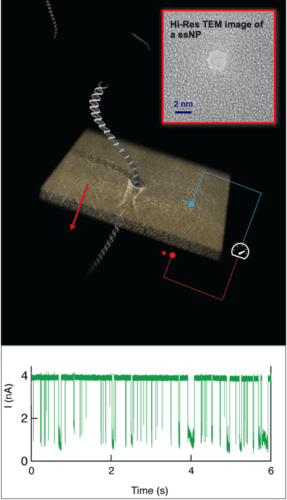The research group of Amit Meller from the Technion won a special grant from the European Union designed to accelerate an innovative technology for drilling nanometer nozzles in a material using a laser beam. The final device will be used for the analysis of a single molecule for the rapid diagnosis of diseases, including COVID-19

The research group of Prof. Amit Meller from the Faculty of Biomedical Engineering at the Technion won an ERC PoC grant - a grant for proof of feasibility, in the amount of 150 thousand euros. The special grant from the European Research Commission was recently awarded to 55 researchers, and it is designed to help them exhaust the commercialization potential of their developments. Prof. Meller's project is called OptiPore and its purpose is to promote innovative technology for the analysis of individual molecules in general and to detect the presence of the SARS-CoV-2 corona virus in particular. The means: developing a fast and cheap innovative method for creating ssNPs - diagnostic devices based on nanometer nozzles.
ssNPs is a new family of devices aimed at the analysis of single biological molecules. Such an analysis has enormous medical and research value, as it replaces existing diagnostic methods based on the analysis of a complete solution - methods characterized by many disadvantages, including high cost, cumbersome equipment and limited accuracy.
To illustrate the quantum leap inherent in ssNPs devices, let's take the SARS-CoV-2 corona virus as an example. The existing corona tests are based on RT-qPCR technology, which requires a long and complex process that includes collecting the sample from the subject using a swab, "opening" the virus to reveal the genetic material inside, extracting the genetic material of the RNA, and "reverse transcription" in which sequences are translated the RNA to DNA sequences. However, this is not the end of the process, because in order for the existing equipment to be able to detect the presence of viruses in a sample, it is performed at this stage exponential amplification (PCR) which repeatedly duplicates the DNA molecules to produce a critical mass of them. Besides the process being long and expensive, the amplification step is created in some cases significant mistakes In determining the presence of the virus, i.e. in deciding whether the subject is verified or negative for corona.
The diagnostic process developed by Prof. Meller's research group completely eliminates the step of exponential amplification and enables direct counting and quantification of the virus molecules. This saves valuable time and avoids the same mistakes. The new method is based on Attracting single biological molecules such as DNA, RNA or proteins, using an electric field, into a "nanometric hole" containing electrical or optical sensors. The electronic output goes through Computational analysis that allows direct and immediate identification and counting of the molecules.
Shortly after the outbreak of the corona epidemic, Prof. Meller began working on adapting this technology to the urgent need for fast and accurate corona tests. Indeed, in the proof of feasibility, the effectiveness of this method was demonstrated in monitoring the presence of SARS-CoV-2 even when the original sample contains a tiny amount of viruses. This process, recently published inDHW Nano, was developed by Prof. Meller and the research team with post-doctoral student Dr. Jana Rozevski and their colleagues at the "Sharita" hospital in Berlin, with the help of an ERC grant allocated by the European Union to accelerate the commercialization of the test.
Now, as mentioned, the group won a supplementary ERC grant. This grant does not focus on the development of the test itself in the manufacturing process of the device, since the drilling of the nozzles is a huge technological challenge that currently hinders the extensive development of ssNPs devices. In a long and in-depth work, Prof. Meller's research group developed a unique technology for drilling the nozzles in the diagnostic devices, using a focused blue laser beam. This technology will now be developed, with the assistance of the grant, to bring it to clinical use as soon as possible.
It is worth noting that although the two grants were awarded at a time when the world is dealing with the corona epidemic, the mentioned technologies are relevant for the diagnosis of many diseases - not only viral and bacterial diseases but also various types of cancer, as has already been demonstrated in a preliminary way in the Technion laboratory. The corona research was done in collaboration with the biobank unit at the Rambam Medical Center.
More of the topic in Hayadan:
